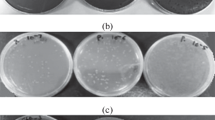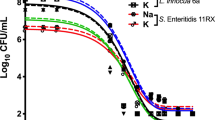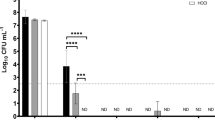Abstract
This present study assessed the chlorine tolerance of some Citrobacter species recovered from secondary effluents from the clarifiers of two wastewater treatment plants in the Eastern Cape, South Africa. The bacterial survival, chlorine lethal dose and inactivation kinetics at lethal doses were examined. Inactivation of the test bacteria (n = 20) at the recommended dose of 0.5 mg/l for 30 min exposure showed a progressive reduction in bacterial population from 4 to 5 log reduction and residuals ranged between 0.12 and 0.46 mg/l. The bactericidal activity of chlorine increased at higher dosages with a substantial reduction in viability of the bacteria and complete inactivation of the bacterial population at a lethal dose of 0.75 and 1.0 mg/l in 30 min. For the inactivation kinetics, bactericidal activity of chlorine increased with time showing a 3.67–5.4 log reduction in 10 min, 4.0–5.6 log reduction in 20 min and above 6.3 log reductions to complete sterilization of bacterial population over 30 min for all the entire test Citrobacter isolates used in this study. Furthermore, there was a strong correlation (R 2 > 0.84) between bacteria inactivation and increase in contact time. This study appears to have provided support for laboratory evidence of bacterial tolerance to chlorine disinfection at current recommended dose (0.5 mg/l for 30 min), and chlorine concentration between 0.75 and 1.0 mg/l was found to have a better disinfecting capacity to check tolerance of Citrobacter species.




Similar content being viewed by others
References
Acharya, S. M., Kurisu, F., Kasuga, I., & Furumai, H. (2016). Chlorine dose determines bacterial community structure of subsequent regrowth in reclaimed water. J. Water Environ. Technol., 14, 15–24.
Adefisoye, M. A., Nwodo, U. U., Green, E., & Okoh, A. I. (2016). Quantitative PCR detection and characterisation of human adenovirus. Rotavirus and Hepatitis A Virus in Discharged Effluents of Two Wastewater Treatment Facilities in the Eastern. Food Environ. Virol., 8, 262–274.
Afifi, M. Z., & Blatchley, E. R. (2015). Seasonal dynamics of water and air chemistry in an indoor chlorinated swimming pool. Water Research, 68, 771–783.
Anastasi, E. M., Wohlsen, T. D., Stratton, H. M., & Katouli, M. (2013). Survival of Escherichia coli in two sewage treatment plants using UV irradiation and chlorination for disinfection. Water Research, 47, 6670–6679.
APHA, AWWA, WEF (1999). Standard methods for the examination of water and wastewater, Standard
Begley, M., Gahan, C. G. M., & Hill, C. (2005). The interaction between bacteria and bile. FEMS Microbiology Reviews, 29, 625–651.
Ceragioli, M., Mols, M., Moezelaar, R., Ghelardi, E., Senesi, S., & Abee, T. (2010). Comparative transcriptomic and phenotypic analysis of the responses of Bacillus cereus to various disinfectant treatments. Applied and Environmental Microbiology, 76, 3352–3360.
Chandy, J. P., & Angles, M. L. (2001). Determination of nutrients limiting biofilm formation and the subsequent impact on disinfectant decay. Pergamon, 35, 2677–2682.
Costet, N., Garlantezec, R., Monfort, C., Rouget, F., Gagniere, B., Chevrier, C., & Cordier, S. (2011). Environmental and urinary markers of prenatal exposure to drinking water disinfection by-products, fetal growth, and duration of gestation in the Pelagie birth cohort (Brittany, France, 2002-2006). American Journal of Epidemiology, 175, 263–275.
Coulliette, A. D., Enger, K. S., Weir, M. H., & Rose, J. B. (2013). Risk reduction assessment of waterborne Salmonella and Vibrio by a chlorine contact disinfectant point-of-use device. International Journal of Hygiene and Environmental Health, 216, 355–361.
DWAF (1996). South African Water Quality Guidelines. Volume 1 Domestic water use, Second edition. http://www.dwa.gov.za/iwqs/wq_guide/Pol_saWQguideFRESHDomestic usevol1.pdf. Accessed 29/12/2014.
DWAF (2013). National Water Act. Department of Water Affairs, South Africa. http://www.faolex.fao/docs/pdf/saf/126916.pdf. Accessed: 28/7/16.
Gomes, I. B., Simões, M., & Simões, L. C. (2016). The effects of sodium hypochlorite against selected drinking water-isolated bacteria in planktonic and sessile states. The Science of the Total Environment, 565, 40–48.
Goshko, M. A., Pipes, W. O., & Christian, R. R. (1983). Coliform occurrence and chlorine residual in small water distribution systems. J. /Am. Water Work. Assoc., 75, 371–374.
Gregg, M., Rigby, G., & Hallegraeff, G. M. (2009). Review of two decades of progress in the development of management options for reducing or eradicating phytoplankton, zooplankton and bacteria in ship’s ballast water. Aquatic Invasions, 4, 521–565.
Hall, T. A. (1999). BioEdit: a user-friendly biological sequence alignment editor and analysis program for Windows 95/98/NT. Nucleic Acids Symposium Series, 41, 95–98.
Helbling, D. E., & Vanbriesen, J. M. (2007). Free chlorine demand and cell survival of microbial suspensions. Water Research, 41, 4424–4434.
Holmes, B., & Auken, H. (1998). Citrobacter, Enterobactericeae, Klebsilla, Serratia and other members of the Enterobactericeae. In L. Collier, A. Balows, & M. Sussman (Eds.), Microbiology and microbial infections. Systematic Bacteriology (9th ed., pp. 999–1033). London: Arnold.
Howard, K., & Inglis, T. J. J. (2005). Disinfection of Burkholderia pseudomallei in potable water. Water Research, 39, 1085–1092.
Hrudey, S.E., Hrudey, E.J. (2007). Published case studies of waterborne disease outbreaks—evidence of a recurrent threat. Water Environ. Res. 233–245.
Igbinosa, I. H., & Okoh, A. I. (2012). Antibiotic susceptibility profile of Aeromonas species isolated from wastewater treatment plant. Scientific World Journal, 2012, 1–6.
Jin, A. J., Feng, L., Zhang, L. Q., & Liu, Y. Z. (2016). Changes of the toxic potential of drinking water containing aminopyrine before and after chlorine disinfection as determined by the algal toxicity assay and the SOS/umu assay. International Biodeterioration and Biodegradation, 113, 269–275.
Koivunen, J., & Heinonen-Tanski, H. (2005). Inactivation of enteric microorganisms with chemical disinfectants. UV irradiation and combined chemical/UV treatments. Water Res., 39, 1519–1526.
Lane, D. (1991). 16S/23S rRNA sequencing. In E. Stackebrandt & M. Goodfellow (Eds.), Nucleic acid techniques in bacterial systematics. Chichester: John Wiley & Sons, Ltd..
Lavigne, J., Defez, C., Bouziges, N., Mahamat, A., & Sotto, A. (2007). Clinical and molecular epidermiology of multi-drug resistant Citrobacter sp. infections in a french University hospital. European Journal of Clinical Microbiology & Infectious Diseases, 26, 439–441.
Levantesi, C., La Mantia, R., Masciopinto, C., Böckelmann, U., Ayuso-Gabella, M. N., Salgot, M., Tandoi, V., Van Houtte, E., Wintgens, T., & Grohmann, E. (2010). Quantification of pathogenic microorganisms and microbial indicators in three wastewater reclamation and managed aquifer recharge facilities in Europe. The Science of the Total Environment, 408, 4923–4930.
Lloyds-Register (2012). Ballast water treatment technologies and current system availability. Understanding Ballast Water Management Series.
Macauley, J. J., Qiang, Z., Adams, C. D., Surampalli, R., & Mormile, M. R. (2006). Disinfection of swine wastewater using chlorine, ultraviolet light and ozone. Water Research, 40, 2017–2026.
Maier, H. (2015) Investigations to the application of chlorination- and dechlorination methods for water treatment systems in emergencies. http://www.epubs.surrey.ac.uk/810657/1/MPhil%20Hannes%20Maier.pdf. Accessed 11/4/2016
Martínez-Hernández, S., Vázquez-Rodríguez, G. A., Beltrán-Hernández, R.I., Prieto-García, F., Miranda-López, J.M., Franco-Abuín, C.M., Álvarez-Hernández, A., Iturbe, U., Coronel-Olivares, C. (2013). Resistance and inactivation kinetics of bacterial strains isolated from the non-chlorinated and chlorinated effluents of a WWTP Int. J. Environ. Res. Public Health 10, 3363–3383.
Mazik, K., Hitchman, N., Quintino, V., Taylor, C. J. L., Butterfield, J., & Elliott, M. (2013). Sublethal effects of a chlorinated and heated effluent on the physiology of the mussel, Mytilus edulis L.: a reduction in fitness for survival? Marine Pollution Bulletin, 77, 123–131.
Miranda, A. C., Lepretti, M., Rizzo, L., Caputo, I., Vaiano, V., Sacco, O., Lopes, W. S., & Sannino, D. (2016). Surface water disinfection by chlorination and advanced oxidation processes: inactivation of an antibiotic resistant E. coli strain and cytotoxicity evaluation. Sci. Total Environ., 554–555, 1–6.
Narotsky, M. G., Klinefelter, G. R., Goldman, J. M., Deangelo, A. B., Best, D. S., Mcdonald, A., Strader, L. F., Murr, A. S., Suarez, J. D., George, M. H., Iii, E. S. H., & Simmons, J. E. (2015). Reproductive toxicity of a mixture of regulated drinking-water disinfection by-products in a multigenerational rat bioassay. Environmental Health Perspectives, 564, 564–570.
Nieuwenhuijsen, M. J., Toledano, M. B., Eaton, N. E., Fawell, J., & Elliott, P. (2000). Chlorination disinfection byproducts in water and their association with adverse reproductive outcomes: a review. Occupational and Environmental Medicine, 57, 73–85.
Okoh, A. I., Sibanda, T., Nongogo, V., Adefisoye, M., Olayemi, O. O., & Nontongana, N. (2015). Prevalence and characterisation of non-cholerae Vibrio spp. in final effluents of wastewater treatment facilities in two districts of the Eastern Cape Province of South Africa: implications for public health. Environmental Science and Pollution Research International, 22, 2008–2017.
Oliver, J. D. (2010). Recent findings on the viable but nonculturable state in pathogenic bacteria. FEMS Microbiology Reviews, 34, 415–425.
Osuolale, O., Okoh, A. (2015). Assessment of the physicochemical qualities and prevalence of Escherichia coli and Vibrios in the final effluents of two wastewater treatment plants in South Africa: ecological and public health implications Int. J. Environ. Res. Public Health 12, 13399–13412.
Pang, Y., Huang, J., Xi, J., Hu, H., & Zhu, Y. (2016). Effect of ultraviolet irradiation and chlorination on ampicillin-resistant Escherichia coli and its ampicillin resistance gene. Frontiers of Environmental Science & Engineering, 10, 522–530.
Pepperell, C., Kus, J. V., Gardam, M. A., Humar, A., & Burrows, L. D. (2002). Virulence Citrobater species encode resistance to multiple antimicrobials. Antimicobial Agents Chemother., 46(11), 3555–3560.
Pignata, C., Fea, E., Rovere, R., Degan, R., Lorenzi, E., De Ceglia, M., Schilirò, T., & Gilli, G. (2012). Chlorination in a wastewater treatment plant: acute toxicity effects of the effluent and of the recipient water body. Environmental Monitoring and Assessment, 184, 2091–2103.
Rauen, W. B., Angeloudis, A., & Falconer, R. A. (2012). Appraisal of chlorine contact tank modelling practices. Water Research, 46, 5834–5847.
Ryan, K. J. (2004). Enterobactericeae. In K. J. Ryan & C. G. Ray (Eds.), Sherris Medical Micobiology: An Introduction to infectious diseases (4th ed., pp. 343–347). USA: McGraw-Hill.
Samie, A., Obi, C. L., Igumbor, J. O., & Momba, M. N. B. (2009). Focus on 14 sewage treatment plants in the Mpumalanga Province, South Africa in order to gauge the efficiency of wastewater treatment. African J. Biotechnol., 8, 3276–3285.
Samonis, G., Karageorgopoulos, D. E., Kofteridis, D. P., Mathacou, D., Sidiropoulou, V., Maraki, S., & Falagas, M. E. (2009). Citrobacter infections in a general hospital: characterstics and outcomes. European Journal of Clinical Microbiology & Infectious Diseases, 28, 61–68.
Shang, & Blatchley. (2001). Chlorination of pure bacterial cultures in aqueous solution. Pergamon, 35, 244–254.
Shi, P., Jia, S., Zhang, X.-X., Zhang, T., Cheng, S., & Li, A. (2013). Metagenomic insights into chlorination effects on microbial antibiotic resistance in drinking water. Water Research, 47, 111–120.
Sinbuathong, N., Kongseri, B., & Plungklang, P. (2000). Cyanide removal from laboratory wastewater using sodium hypochlorite and calcium hypochlorite. Natural Science, 34, 74–78.
Smith, R. B., Edwards, S. C., Best, N., Wright, J., Nieuwenhuijsen, M. J., & Toledano, M. B. (2016). Research| children’s health birth weight, ethnicity, and exposure to trihalomethanes and haloacetic acids in drinking water during pregnancy in the born in Bradford cohort. Environmental Health Perspectives, 124, 681–689.
Sobsey, M.D. (2002) Managing Water in the Home : Accelerated Health Gains from Improved Water Supply. World Health Organization 8: 1–70
Teklehaimanot, G. Z., Coetzee, M. A. A., & Momba, M. N. B. (2014). Faecal pollution loads in the wastewater effluents and receiving water bodies: a potential threat to the health of Sedibeng and Soshanguve communities, South Africa. Environmental Science and Pollution Research, 21, 9589–9603.
Tree, J. A., Adams, M. R., & Lees, D. N. (2003). Chlorination of indicator bacteria and viruses in primary sewage effluent chlorination of indicator bacteria and viruses in primary sewage effluent. Applied and Environmental Microbiology, 69, 2038–2043.
Tsolaki, E., & Diamadopoulos, E. (2010). Technologies for ballast water treatment: a review. Journal of Chemical Technology and Biotechnology, 85, 19–32.
Turner, S., Pryer, K. M., Miao, V. P., & Palmer, J. D. (1999). turner-et-al-jeb-1999.original.pdf. The Journal of Eukaryotic Microbiology, 46, 327–338.
United Nations Environment Programme (2010). Sick water? The central role of wastewater management in sustainable development. http://www.unep.org/pdf/SickWater_screen.pdf. Accessed: 12/5/2016.
Valero, P., Mosteo, R., Ormad, M. P., Lázaro, L., & Ovelleiro, J. L. (2015). Inactivation of Enterococcus sp. by conventional and advanced oxidation processes in synthetic treated urban wastewater. Ozone Science and Engineering, 9512, 150527104200005.
Virto, R., Sanz, D., Alvarez, I., Condon, S., & Raso, J. (2004). Relationship between inactivation kinetics of a Listeria monocytogenes suspension by chlorine and its chlorine demand. Journal of Applied Microbiology, 97, 1281–1288.
Werschkun, B., Sommer, Y., & Banerji, S. (2012). Disinfection by-products in ballast water treatment: an evaluation of regulatory data. Water Research, 46, 4884–4901.
WHO (2001). Guidelines: the current position. In: Lorna F, Jamie B (eds) Water quality: Guidelines, Standards and Health. IWA Publishing, London, UK. http://www.who.int/water_sanitation_health/dwq/iwachap2.pdf. Accessed 19/05/2016.
WHO (2006). Guidelines for Drinking-water Quality. World Heal. Organ. 1, 1–597. http://www.who.int/water_sanitation_health/dwq/gdwq0506.pdf. Accessed 19/02/2016.
Wilson, M. (2005). Microbial inhabitants of humans. Their ecology and role in health and disease. Cambridge: Cambridge University Press.
World Health Organization (2003). Chlorine in Drinking-water. Background document for the development of WHO guidelines for drinking-water Quality. http://www.who.int/water_sanitation_health/dwq/chlorine.pdf.
Zamyadi, A., Ho, L., Newcombe, G., Bustamante, H., & Prévost, M. (2012). Fate of toxic cyanobacterial cells and disinfection by-products formation after chlorination. Water Research, 46, 1524–1535.
Zhou, B., Luo, Y., Nou, X., Lyu, S., & Wang, Q. (2015). Inactivation dynamics of Salmonella enterica, Listeria monocytogenes, and Escherichia coli O157:H7 in wash water during simulated chlorine depletion and replenishment processes. Food Microbiology, 50, 88–96.
Acknowledgements
We are grateful to the South Africa Medical Research Council (SAMRC), the University of Fort Hare and Nigeria Tertiary Education Fund (TETFUND) for the financial support.
Author information
Authors and Affiliations
Corresponding author
Rights and permissions
About this article
Cite this article
Owoseni, M., Okoh, A. Assessment of chlorine tolerance profile of Citrobacter species recovered from wastewater treatment plants in Eastern Cape, South Africa. Environ Monit Assess 189, 201 (2017). https://doi.org/10.1007/s10661-017-5900-z
Received:
Accepted:
Published:
DOI: https://doi.org/10.1007/s10661-017-5900-z




